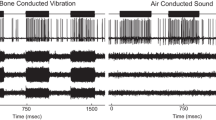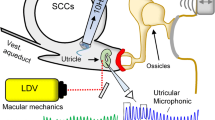Abstract
A field potential can be defined as the ‘synchronous’ firing of many of vestibuloacoustic nerve fibres. Electrovestibulography has been considered as a method to record and detect vestibuloacoustic signals originating mainly from the vestibular system. A clear picture of the likely acoustic, vestibular or vestibuloacoustic origin and the physiologic basis of these field potentials is lacking. Recordings were conducted on anesthetized Guinea Pigs [ketamine (60 mg/kg) and xylazine (6 mg/kg)] to determine the origin of these minute spontaneous field potentials detected, recorded and averaged during Electrovestibulography recordings. Recordings were made with (1) normal hearing and balance (vestibular function), (2) following cisplatin deafening then (3) following both cisplatin deafening and gentamicin vestibular ablation. The detected minute spontaneous field potentials were determined to be both acoustic and vestibular in origin i.e., vestibuloacoustic. Based on the spontaneous activity of acoustic and vestibular nerve fibers arguments are presented that these field potentials are predominantly vestibular.


Similar content being viewed by others
References
Lithgow, B. J. (2012). A methodology for detecting field potentials from the external ear canal: NEER and EVestG. Annals of Biomedical Engineering, 40, 1835–1850.
Lithgow, B. J., & Shoushtarian, M. (2015). Parkinson’s disease: Disturbed vestibular function and levodopa. Journal of the Neurological Sciences, 353, 49–58.
Gurvich, C., Maller, J. J., Lithgow, B., Haghgooie, S., & Kulkarni, J. (2013). Vestibular insights into cognition and psychiatry. Brain Research, 1537, 244–259.
Lithgow, B. J., Garrett, A. L., Moussavi, Z. M., Gurvich, C., Kulkarni, J., Maller, J. J., et al. (2015). Major depression and electrovestibulography. World Journal of Biological Psychiatry, 16, 334–350.
Blakley, B., Dastgheib, Z., Lithgow, B. J., & Moussavi, Z. (2014). Preliminary report: neural Firing Patterns specific for Meniere’s Disease. Journal of Otolaryngology–Head and Neck Surgery, 43, 5.
Dastgheib, Z., Lithgow, B. J., Blakley, B., & Moussavi, Z. (2014). A new diagnostic vestibular evoked response. Journal of Otolaryngology–Head and Neck Surgery, 44, 14.
Gibson, W., Prasher, D. K., & Kilkenney, G. P. G. (1983). Diagnostic significance of transtympanic electrocochleography in Meniere’s disease. Annals of Otology, Rhinology & Laryngology, 92, 155–159.
Gibson, W. P. R., Moffat, D. A., & Ramsden, R. T. (1977). Clinical electrocochleography in the diagnosis and management of Meniere’s disorder. Audiology, 16, 389–401.
Myers, S. F., Blakley, B. W., & Schwan, S. (1993). Is cis-platinum vestibulotoxic? Otolaryngology—Head and Neck Surgery, 108, 322–328.
Blakley, B. W. (2000). Update on intratympanic gentamicin for Meniere’s Disease. Laryngoscope, 110, 236–242.
Blakley, B. W. (1999). Kinetics of gentamicin uptake. Otolaryngology-Head and Neck Surgery, 121, 510.
Perg, J. A., Niven, J. E., Mugnaini, E., Balasubramanian, V., & Sterling, P. (2012). Why do axons differ in caliber? Journal of Neuroscience, 32, 626–638.
Oak, M., & Yi, E. (2014). Voltage-gated K+ channels contributing to temporal precision at the inner hair cell-auditory nerve fiber synapses in the mammalian cochlea. Archives of Pharmacal Research, 37, 821–833.
Beddard, C., Kroger, H., & Destexhe, A. (2004). Modeling extracellular field potentials and the frequency-filtering properties of extracellular space. Biophysics Journal, 86, 1829–1842.
Flint, P. W., Haughey, B. H., Lund, V. J., Niparko, J. K., Richardson, M. A., Thomas Robbins, K., et al. (2014). Cummings Otolaryngology: Head and Neck Surgery (6th ed.). Amsterdam: Elsevier - Health Sciences Division.
Baloh, R. W., Honrubia, V., & Kerber, K. A. (2011). Clinical Neurophysiology of the Vestibular System (4th ed.). Oxford: Oxford University Press.
Goldberg, J. M. (2000). Afferent diversity and the organization of central vestibular pathways. Experimental Brain Research, 130, 277–297.
Acknowledgement
This study was supported by Neural Diagnostics Ltd.
Author information
Authors and Affiliations
Corresponding author
Ethics declarations
Conflict of interest
BL has < 0.5% shares in Neural Diagnostics Pty. Ltd. and is part time consultant for them.
Ethical Approval
All procedures performed in studies involving animals were in accordance with the ethical standards of the institution or practice at which the studies were conducted.
Rights and permissions
About this article
Cite this article
Blakley, B., Suleiman, A., Rutherford, G. et al. EVestG Recordings are Vestibuloacoustic Signals. J. Med. Biol. Eng. 39, 213–217 (2019). https://doi.org/10.1007/s40846-018-0398-6
Received:
Accepted:
Published:
Issue Date:
DOI: https://doi.org/10.1007/s40846-018-0398-6




